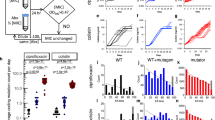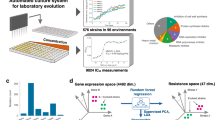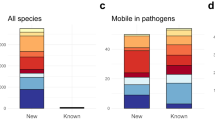Abstract
Directed evolution can be a powerful tool to predict antibiotic resistance. Resistance involves the accumulation of mutations beneficial to the pathogen while maintaining residue interactions and core packing that are critical for preserving function. The constraint of maintaining stability, while increasing activity, drastically reduces the number of possible mutational combination pathways. To test this theory, TEM-1 β-lactamase was evolved using a hypermutator E. coli-based directed evolution technique with cefotaxime selection. The selected mutants were compared to two previous directed evolution studies and a database of clinical isolates. In all cases, evolution resulted in the generation of the E104K/M182T/G238S combination of mutations (∼500-fold increased resistance), which is equivalent to clinical isolate TEM-52. The structure of TEM-52 was determined to 2.4 Å. G238S widens access to the active site by 2.8 Å whereas E104K stabilizes the reorganized topology. The M182T mutation is located 17 Å from the active site and appears to be a global suppressor mutation that acts to stabilize the new enzyme structure. Our results demonstrate that directed evolution coupled with structural analysis can be used to predict future mutations that lead to increased antibiotic resistance.
This is a preview of subscription content, access via your institution
Access options
Subscribe to this journal
Receive 12 print issues and online access
$189.00 per year
only $15.75 per issue
Buy this article
- Purchase on Springer Link
- Instant access to full article PDF
Prices may be subject to local taxes which are calculated during checkout




Similar content being viewed by others
Accession codes
References
Stemmer, W.P. Nature 370, 389–391 (1994).
Zaccolo, M. & Gherardi, E. J. Mol. Biol. 285, 775–783 (1999).
Jacoby, G. & Bush, K. http://www.lahey.org/studies/webt.htm (2000).
Poyart, C., Mugnier, P., Quesne, G., Berche, P. & Trieu-Cuot, P. Antimicrob. Agents Chemother. 42, 108–113 (1998).
Giakkoupi, P., Tzelepi, E., Tassios, P.T., Legakis, N.J. & Tzouvelekis, L. S. J. Antimicrob. Chemother. 45, 101–104 (2000).
Skandalis, A., Encell, L.P. & Loeb, L.A. Chem. Biol. 4, 889–898 (1997).
Echols, H., Lu, C. & Burgers, P.M. J. Proc. Natl. Acad. Sci. USA 80, 2189–2192 (1983).
Low, N.M., Holliger, P.H. & Winter, G. J. Mol. Biol . 260, 359–368 (1996).
Knox, J. Antimicrob. Agents Chemother. 39, 2593–2601 (1995).
Matagne, A., Lamotte-Brasseur, J. & Frere, J.M. Biochem. J. 330, 581–598 (1998).
Raquet, X. et al. Proteins 23, 63–72 (1995).
Du Bois, S.K., Marriott, M. S. & Amyes, S.G.B. J. Antimicrob. Chemother. 35, 7–22 (1995).
Long-McGie, J., Liu, A.D. & Schellenberger, V. Biotechnol. Bioeng. 68, 121–125 (2000).
Medeiros, A.A. Clin. Infect. Dis. 24 (Suppl. 1), S19–45 (1997).
Huang, W. & Palzkill, T. Proc. Natl. Acad. Sci. USA 94, 8801–8806 (1997).
Farzaneh, S. et al. Antimicrob. Agents Chemother. 40, 2434–2436 (1996).
Huang, W., Petrosino, J., Hirsch, M., Shenkin, P.S. & Palzkill, T. J. Mol. Biol. 258, 688–703 (1996).
Yang, Y., Bhachech, N., Bradford, P.A., Jett, B.D., Sahm, D.F. & Bush, K. Antimicrob. Agents Chemother. 42,1671–1676 (1998).
Aramli, L.A. & Teschke, C.M. J. Biol. Chem. 274, 22217–22224 (1999).
Nikolova, P.V., Wong, K.B., DeDecker, B., Henckel, J. & Fersht, A.R. EMBO J. 19, 370–378 (2000).
Vanhove, M., Lejeune, A. & Pain, R.H. Cell. Mol. Life Sci. 54, 372–377 (1998).
Jelsch, C., Mourey, L., Masson, J. & Samama., J. Proteins 16, 364–383 (1993).
Otwinowski, Z. & Minor, W. Methods Enzymol. 276, 307–326 (1997).
Navaza, J. Acta. Crystallogr. A 50, 157–163 (1994).
Jones, T.A., Zou, J.Y., Cowan, S.W. & Kjeldgaard, M. Acta. Crystallgr. A 47, 110–119 (1991).
Brunger, A.T. et al. Acta Crystallogr. D 54, 905–921 (1998).
Acknowledgements
This work was supported in part by the Scripps Research Institute.
Author information
Authors and Affiliations
Corresponding author
Rights and permissions
About this article
Cite this article
Orencia, M., Yoon, J., Ness, J. et al. Predicting the emergence of antibiotic resistance by directed evolution and structural analysis. Nat Struct Mol Biol 8, 238–242 (2001). https://doi.org/10.1038/84981
Received:
Accepted:
Issue Date:
DOI: https://doi.org/10.1038/84981
This article is cited by
-
Deep learning the structural determinants of protein biochemical properties by comparing structural ensembles with DiffNets
Nature Communications (2021)
-
Recent advances in the discovery of novel marine natural products and mycosporine-like amino acid UV-absorbing compounds
Applied Microbiology and Biotechnology (2021)
-
The evolution of substrate discrimination in macrolide antibiotic resistance enzymes
Nature Communications (2018)
-
Environmental pleiotropy and demographic history direct adaptation under antibiotic selection
Heredity (2018)
-
Mistranslation can enhance fitness through purging of deleterious mutations
Nature Communications (2017)



